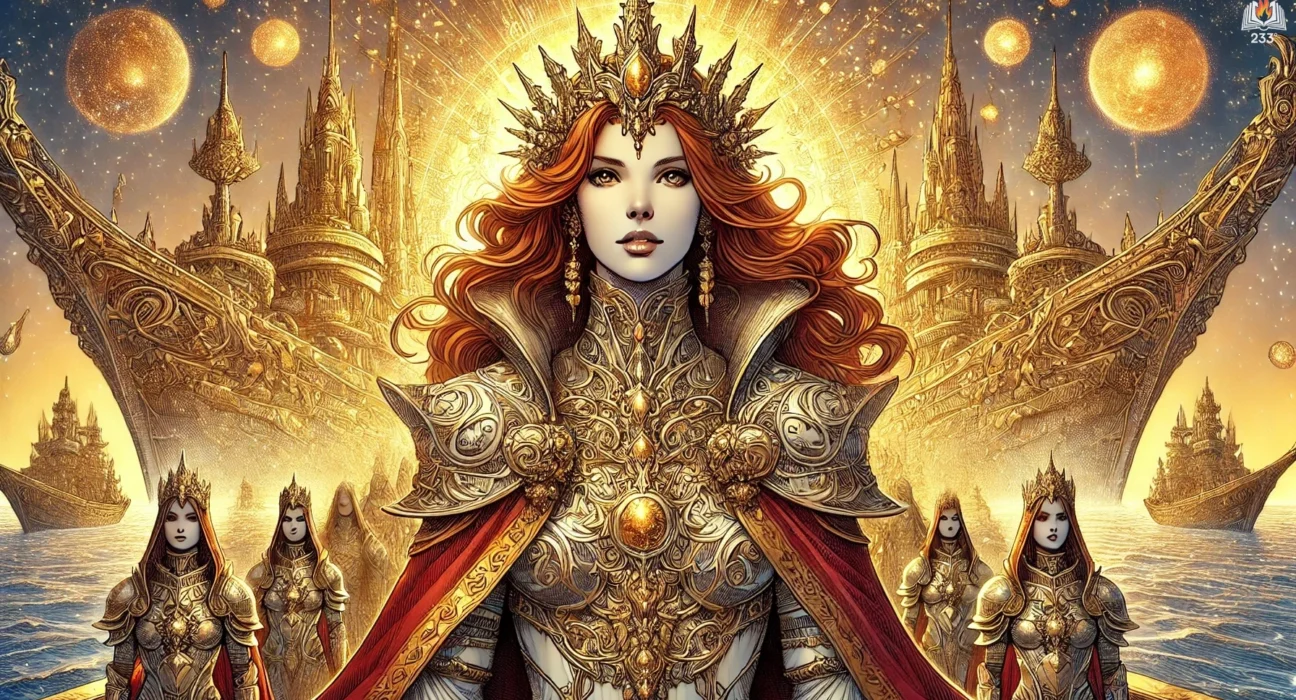The Blazing World by Margaret Cavendish, published in 1666, is a groundbreaking work of speculative fiction and early science fiction. It blends elements of utopian literature, fantasy, and philosophical discourse. Cavendish, an English aristocrat and polymath, uses this narrative to explore themes of power, gender, and knowledge. The novel is recognized for its feminist undertones and its forward-thinking ideas about science, government, and society. Set in an alternate universe, The Blazing World follows a woman who becomes the ruler of a fantastical world inhabited by strange creatures, through whom she explores philosophical and scientific ideas.
Plot Summary
Swept away by the violent winds of fate, a young woman found herself caught between worlds. Her journey began when a merchant, consumed with passion for her beauty, stole her away from the peaceful shore near her home. As their small vessel was driven by fierce tempests, the ship careened through icy seas, carrying them farther north than any sailor had ever dared. The crew, helpless against the bitter cold, perished one by one, their bodies frozen in grotesque stillness. The lone survivor, the young woman, endured the perilous voyage by the warmth of her own youth and beauty. It seemed the very gods were protecting her.
The ship, no longer controlled by human hands, drifted through a narrow passage into an unknown land, a world alight with strange wonders. There, the ship was met by strange creatures—upright figures resembling bears, with soft, paw-like hands. These beings, though fearsome in appearance, were kind and gentle. They rescued her from the wreckage of the ship and carried her through glittering icy plains to their underground city. The woman marveled at their civility, so at odds with their savage exteriors. Despite her fears, she was treated with great respect and kindness.
Her journey continued as the bear-men presented her to a race of fox-like creatures who, in turn, escorted her across another river. In this new land, she encountered bird-men with the heads and wings of geese, followed by satyrs and other fantastic beings. Each of these peoples marveled at her beauty and treated her with honor, each passing her from one group to the next as a valuable gift destined for the greatest ruler of all—the Emperor of the Blazing World.
The Emperor’s kingdom, an astonishing and radiant land, was unlike any she had ever seen. Cities of precious materials rose from the landscape, their streets paved with jewels and gold. At the heart of this empire stood the imperial city, Paradise, resplendent with rivers of crystal water, and bridges that shimmered like the sun. The imperial palace itself was a marvel, its golden walls adorned with diamonds, rubies, and emeralds. Towers of alabaster and marble reached into the sky, while vast gardens bloomed with every imaginable flower. In this utopia, there was no war, no suffering—only peace, prosperity, and learning.
When the woman was presented to the Emperor, he was struck by her divine appearance and, believing her to be a goddess, immediately sought to worship her. But she, having now mastered their language through observation and intuition, assured him that she was mortal. Smitten by her beauty and intelligence, the Emperor took her as his bride and crowned her the Empress of the Blazing World. With this new power, she was given absolute authority, not only over the Emperor’s vast empire but also over its knowledge, governance, and scientific pursuits.
Embracing her new role, the Empress set out to reform the kingdom. She gathered the strange hybrid creatures—bear-men, bird-men, worm-men, and more—each of whom represented a different branch of knowledge. The bear-men were made the experimental philosophers, the bird-men her astronomers, and the fox-men her political advisors. She created schools and academies where each species could develop their expertise, and through them, she delved into the mysteries of the universe.
The Empress was not content to simply rule; she was a seeker of wisdom, a philosopher-queen. She ordered her subjects to build telescopes to explore the heavens, and microscopes to examine the smallest elements of nature. Under her guidance, the scientists of the Blazing World made remarkable discoveries about the nature of stars, planets, and the cosmos. They examined light and heat, and through their telescopes, they observed phenomena beyond what had ever been imagined. Yet, despite all their efforts, the Empress found that the tools of science often led to disagreement and confusion among her scholars, for no two observers saw the universe the same way. Frustrated, she commanded the destruction of the telescopes and microscopes, urging her subjects to trust their natural senses and reasoning.
Her curiosity was not limited to the material world; she also sought knowledge of religion and governance. When she questioned the priests of the land, she was astonished to find that, despite the many different species in the Blazing World, all its people worshiped one god and shared one religion. This unity in faith and devotion struck her as a model of perfect harmony. Unlike the fractured and often warring religious factions of her homeland, this world was ruled by peace and consensus.
Yet, despite the tranquility of her reign, the Empress could not forget the world she had come from. She missed her homeland and yearned to know what had become of it. Using her newfound powers, she summoned her spirit to travel across dimensions and return to her own world. There, she discovered that her native land was embroiled in war. Moved by compassion and a sense of duty, she used her knowledge and the resources of the Blazing World to assist her people. She sent fleets of golden ships, armed with powerful weapons, to defend her home against its enemies.
Even though her interventions were successful, the Empress realized that ruling two worlds was a strain on her spirit. She returned to the Blazing World and resolved to focus on her empire there, a place of peace and intellectual curiosity. In this utopia, the Empress found fulfillment not just in power but in the pursuit of knowledge, surrounded by loyal subjects who revered her as both a ruler and a scholar. Thus, she continued to govern wisely, ensuring the prosperity and happiness of her people, in a world ablaze with wonders.
Main Characters
The Lady/Empress: The protagonist of the story is an unnamed woman who, after being kidnapped and carried to a new world, eventually becomes its empress. Intelligent, resourceful, and curious, she embodies the ideal of the philosopher-queen. Throughout the narrative, she explores the new world through both her political authority and intellectual curiosity, establishing her dominance while also engaging with the scientific and metaphysical discourses of her time.
The Emperor of the Blazing World: The ruler of the fantastical land the protagonist is transported to. Initially, he is awestruck by her and quickly marries her, making her the empress. Though powerful, his role is secondary, as the protagonist assumes control of the empire’s governance and intellectual pursuits.
Various Inhabitants (Bear-men, Bird-men, Fox-men, etc.): The citizens of the Blazing World are hybrid creatures with both human and animal traits. Each species has a specific role within the society (e.g., the Bear-men are experimental philosophers, the Bird-men are astronomers). These beings are significant because they represent different aspects of knowledge, and their specialized abilities are instrumental to the protagonist’s governance and explorations.
Theme
Power and Authority: One of the central themes in The Blazing World is the protagonist’s rise to supreme authority. Through her marriage to the emperor, she becomes the sovereign ruler, wielding absolute power. Cavendish explores how power, when wielded by a woman, can both sustain and transform society, challenging the traditional patriarchal structures.
Gender and Feminism: Cavendish uses the empress as a symbol of female empowerment. In a time when women had little agency, the protagonist is a figure of immense power and intellect, governing her world with wisdom and authority. This motif ties into Cavendish’s broader philosophical ideas about the roles women can and should play in society.
Utopian Society: The Blazing World is depicted as a utopian realm where peace, order, and happiness reign. The empress’s rule further enhances this world, as she institutes reforms based on reason and justice. The utopian theme reflects the author’s vision of an ideal society, free from the flaws of 17th-century Europe, such as war, division, and inequality.
Science and Philosophy: The novel is deeply engaged with the scientific debates of Cavendish’s time. The inhabitants of the Blazing World are dedicated to various scientific disciplines, and through them, the empress engages in experiments and philosophical discussions, making the novel a commentary on the emerging field of experimental science and natural philosophy.
Writing Style and Tone
Margaret Cavendish’s writing style in The Blazing World is ornate and imaginative, filled with detailed descriptions of fantastical creatures, landscapes, and scientific concepts. Her prose often reflects the elaborate and formal style of the 17th century, with long, intricate sentences and a poetic quality. Despite this complexity, the tone remains clear, conveying her philosophical ideas and the overarching utopian vision with precision and clarity. Cavendish frequently indulges in philosophical dialogues, reminiscent of Platonic dialogues, which lends a speculative and reflective mood to the narrative.
The tone of the novel is a fascinating blend of utopian idealism and scientific curiosity. Cavendish writes with a certain optimism about the possibilities of science, reason, and female leadership, even as she presents a fantastical vision of a world governed by an enlightened ruler. The philosophical discussions often carry a didactic tone, as the empress learns and then applies various scientific and metaphysical concepts, reflecting Cavendish’s own intellectual interests. However, the work also maintains a playful and imaginative tone, especially in its descriptions of the hybrid creatures and their interactions with the protagonist.
We hope this summary has sparked your interest and would appreciate you following Celsius 233 on social media:
There’s a treasure trove of other fascinating book summaries waiting for you. Check out our collection of stories that inspire, thrill, and provoke thought, just like this one by checking out the Book Shelf or the Library
Remember, while our summaries capture the essence, they can never replace the full experience of reading the book. If this summary intrigued you, consider diving into the complete story – buy the book and immerse yourself in the author’s original work.
If you want to request a book summary, click here.
When Saurabh is not working/watching football/reading books/traveling, you can reach him via Twitter/X, LinkedIn, or Threads
Restart reading!








